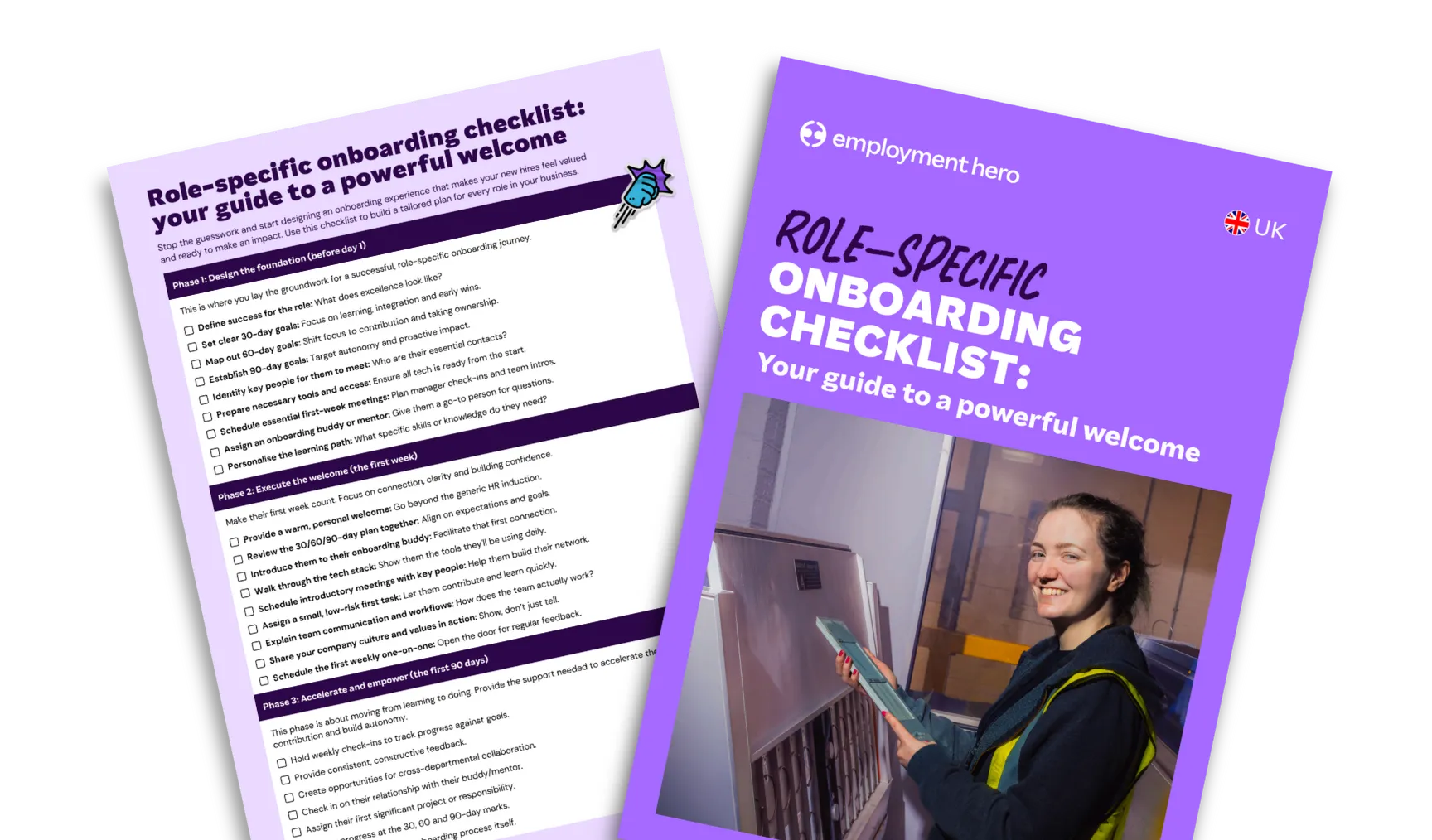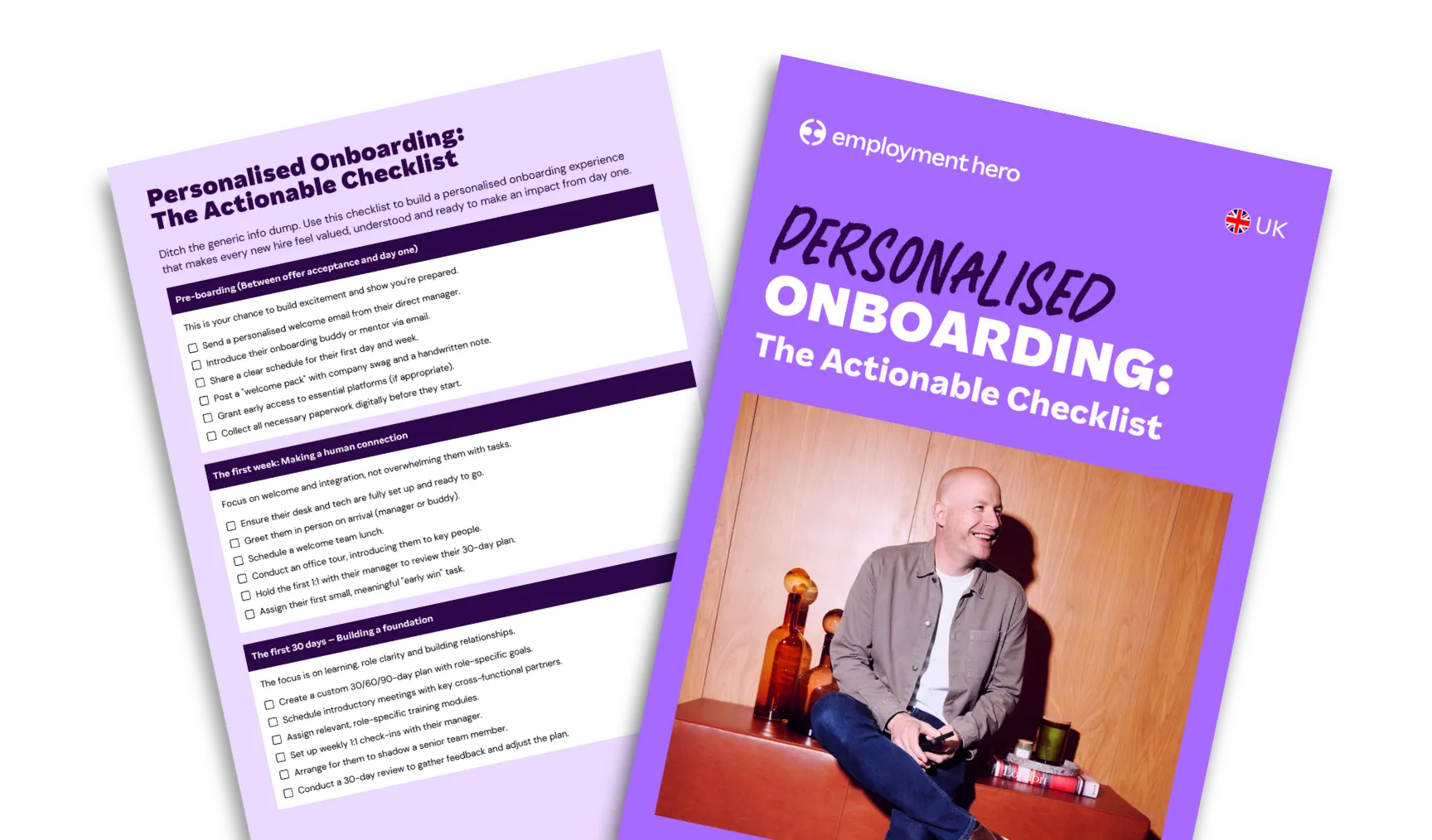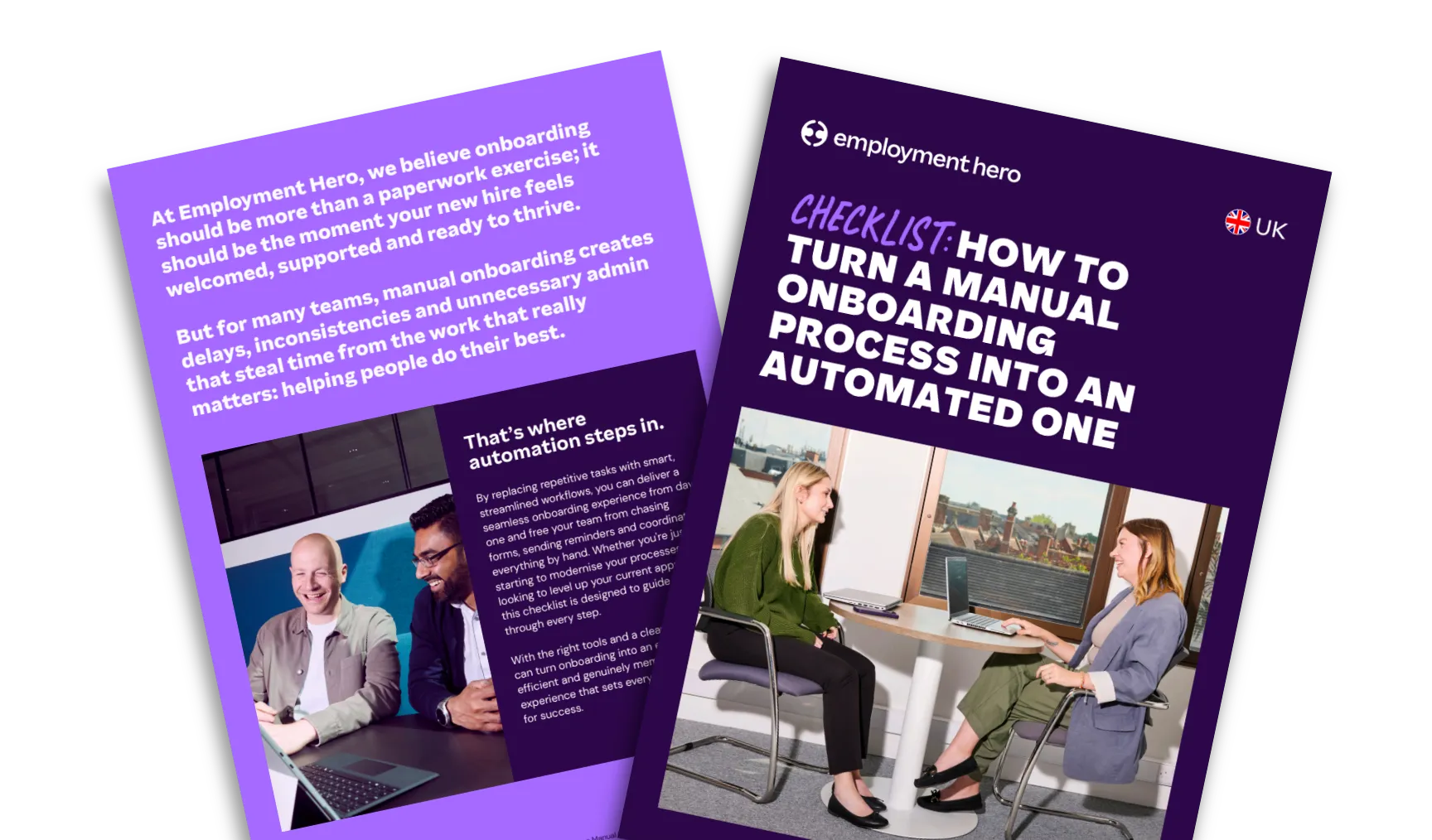Employee offboarding checklist: A guide
Published
Employee offboarding checklist: A guide
Published
1 min read
Employee exits are a natural part of the workplace, but without the right process, they can quickly become stressful for HR teams, managers and remaining team members. That’s why an employee offboarding checklist is so important.
To help you get your exit processes right with ease, we’ve put together an offboarding checklist. The free resource includes:
- Pre-offboarding prep
- IT & security steps
- Final pay & documentation
- Communication checklist
- Employee knowledge handover
- Offboarding day actions
- Follow-up actions
Download your free employee offboarding checklist.
What is employee offboarding?
Employee offboarding is the structured process of managing a team member’s exit from your organisation. Having a solid process in place ensures the transition is handled smoothly and professionally for both the departing team member and the business.
It should cover four critical areas:
- Logistics: Managing practical tasks like returning company property, revoking system access and processing final pay.
- Compliance: Ensuring legal and regulatory requirements are met, such as contracts, tax and benefits.
- Knowledge transfer: Capturing and passing on essential information so teams aren’t left with gaps.
- Employee experience: Leaving a positive final impression that strengthens long-term employer reputation.
An employee offboarding checklist brings structure to this process, making sure no step is overlooked.
Why a strong offboarding process matters
A strong employee offboarding checklist does more than just tie up loose ends, it protects your business, supports your team and helps to maintain continuity across the employment lifecycle.
Just as onboarding sets the tone for a new hire’s journey, offboarding shapes the lasting impression they take with them. Together, these processes form a full-circle experience that reflects your company’s culture and values.
Protects company data
When a team member leaves, they often have access to sensitive systems, client information and business-critical files. It is essential to make sure that data management is taken into consideration.
A thorough employee offboarding checklist ensures IT access is revoked, company devices are returned and data is securely managed. This not only prevents potential breaches but also safeguards intellectual property and customer trust.
Ensures legal compliance
From final payslips and benefits documentation to contracts and tax obligations, offboarding is full of HR compliance requirements. Missing a step can result in penalties or legal disputes. A structured process helps HR and managers stay aligned with UK law and ensures team members receive everything they’re entitled to.
Preserves morale
Poorly managed departures can create uncertainty or fuel speculation among remaining team members. Clear communication and a transparent process help preserve trust and stability within teams. Employees feel reassured when they see that exits are handled with professionalism and respect.
Strengthens your brand as an employer
A final day is just as important as their first. A respectful, organised process leaves departing staff with a positive impression of your business. This goodwill can translate into stronger alumni networks, potential boomerang hires and an enhanced employer reputation in the wider market.
Download your free employee offboarding checklist.
Employee offboarding steps
Step 1: Prepare for the offboarding
The first thing you need to do is set internal expectations and document the process. This includes notifying the relevant teams, such as payroll, IT and legal so they can begin working on their respective tasks. It’s also essential to confirm the exit in writing – either by providing the employee with a written notice of termination or by confirming acceptance of their resignation. At this stage, you should also outline any notice requirements, whether that involves the employee working their notice period or receiving payment in lieu. A member of the HR team or the business leader should be across all tasks to coordinate and ensure everything is completed.
Step 2: Communicate the resignation or termination internally
Communication is essential and it reduces speculation, maintains transparency and preserves team morale. So share the news of a team member leaving with their colleagues and key stakeholders. Tailor the message to the context, whether voluntary or involuntary and ensure it’s consistent across all channels.
Step 3: Plan the knowledge transfer
A smooth transition relies on effective knowledge transfer. Encourage the departing team member to document key processes, update shared drives and provide training handovers where needed. This prevents disruption to workflows and helps colleagues feel confident in taking on responsibilities.
Step 4: Secure IT systems and recover assets
One of the most important offboarding steps is safeguarding company data. Revoke access to systems such as email, CRMs, cloud drives and VPNs. Collect company-owned devices like laptops, phones, security passes and any other equipment. A detailed employee offboarding checklist can help ensure no access points are overlooked.
Step 5: Final day logistics
On the last day, make sure all practical matters are completed. This includes collecting ID badges, issuing final payslips and providing information about benefits or entitlements. If appropriate, offer a reference letter and clarify what happens after departure, such as alumni networks or post-employment support.
Step 6: Follow-up actions
After someone has left your team, there are a few final wrap-up tasks. Remove any residual system access, update organisation charts and reassign open projects. This is also a good time to gather feedback through an exit interview, which can provide valuable insights for improving your employee experience.
Common offboarding mistakes to avoid
Even with the best intentions, offboarding can go wrong if the right structure isn’t in place. Overlooking key steps not only creates unnecessary risk but also leaves a poor impression on departing employees and the wider team. By being aware of common pitfalls, you can refine your employee offboarding checklist and make the process smoother for everyone involved.
Not revoking access promptly
Failing to remove system access immediately can expose your business to serious data security risks. Former employees should no longer have entry to email, software or shared drives once they leave.
Poor internal communication
If an employee’s departure is communicated late or not at all, it can spark rumours, confusion and low morale. Transparent, timely communication helps teams adjust and keeps trust intact.
Forgetting legal or compliance steps
Missed paperwork, delayed final payments or incomplete tax and benefits documentation can lead to penalties or disputes. Compliance should be a non-negotiable part of every offboarding process.
Not collecting feedback
Exit interviews are a valuable opportunity to learn from departing employees. Skipping this step means missing insights that could improve retention, culture or management practices.
Skipping documentation
When knowledge transfer and process documentation are neglected, teams may struggle to pick up responsibilities. This can cause inefficiencies and disrupt workflows long after the employee has left.
Avoiding these mistakes ensures that your offboarding is not only compliant and secure but also respectful and professional, leaving employees with a positive final impression of your organisation.
Supercharge your employment processes with Employment Hero
Employee departures don’t have to be disruptive. With the right structure in place, offboarding becomes an opportunity to protect your business, support employees and strengthen your employer brand. A clear and consistent employee offboarding checklist helps you stay compliant, safeguard data and ensure no critical steps are missed.
To make the process simple, download Employment Hero’s free employee offboarding checklist template. It’s a ready-to-use resource designed to guide HR teams and managers through every stage of the offboarding process, ensuring smoother transitions for both employees and organisations.
Get your free employee offboarding checklist.
Register for the downloadable
Related Resources
-
 Read more: Role-specific onboarding: The complete guide and checklist
Read more: Role-specific onboarding: The complete guide and checklistRole-specific onboarding: The complete guide and checklist
Learn how to create a role-specific onboarding plan that engages and empowers new hires. Download the free checklist to personalise…
-
 Read more: Personalised onboarding: The definitive checklist for setting new employees up for success
Read more: Personalised onboarding: The definitive checklist for setting new employees up for successPersonalised onboarding: The definitive checklist for setting new employees up for success
Learn how to create a personalised onboarding process that engages and empowers new hires. Discover actionable tips, examples and best…
-
 Read more: Onboarding Automation: Redefine Your Process With AI
Read more: Onboarding Automation: Redefine Your Process With AIOnboarding Automation: Redefine Your Process With AI
Discover how AI-powered onboarding automation can transform your employee onboarding process. Learn the benefits, challenges and key tasks to automate.
Employee Offboarding Checklist [Free Template]



















